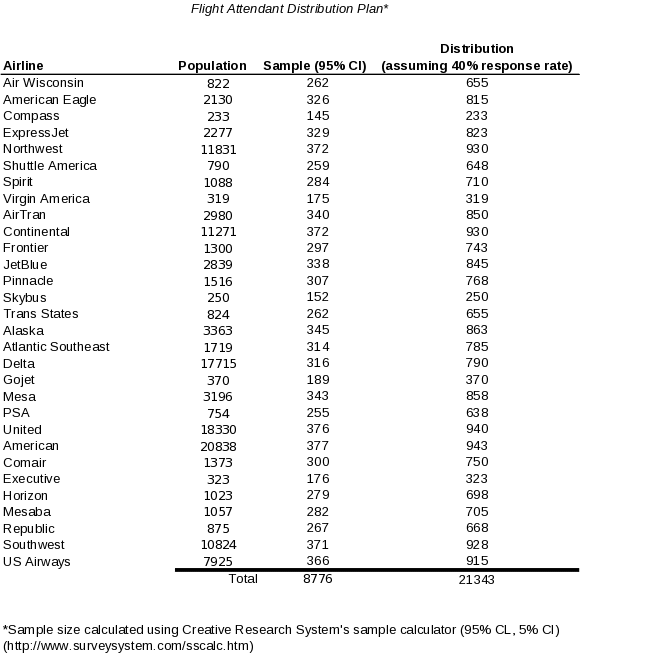FA Fatigue 83-I SS submission 9-24-08_B
FA Fatigue 83-I SS submission 9-24-08_B.doc
National Flight Attendant Duty/Rest/Fatigue Survey
OMB: 2120-0733
B. Statistical Methods
1. Describe the potential respondent universe.
The total respondent universe consists of all flight attendants:
Currently employed as an active flight attendant for a U.S. air carrier (i.e., not furloughed)
Worked for more than 1 month with current airline
Since the number of flight attendants employed by U.S. air carriers varies by month, we can only estimate the number of flight attendants that will be employed at the time of distribution with the 2006 and 2004 Bureau of Transportation Statistics records. Using these numbers as a baseline, we are estimating the total population of respondents will equal approximately 100,000 flight attendants from approximately 30 different air carriers.
The flight attendant lists are being requested from the Flight Attendant Registry. Every active flight attendant is required to register with the registry. The registry is updated frequently by airlines and flight attendants. Additional updates are initiated by the registry to verify address changes and deaths. The flight attendant registry contains information regarding a flight attendant’s age, height, weight, class rating, mailing address, date of issuance, certificate number, place of birth, and employer.
2. Describe the procedures for the collection of information.
A random stratified sampling strategy will be used in this information collection. The stratification variables will be made by air carrier (e.g., Delta, Continental, JetBlue). Given the number of air carriers operating in 2006 and 2004, it is estimated that sampling will be made from approximately 30 different air carriers. The number of flight attendants sampled from each air carrier will be dependent on the number of flight attendants employed by each air carrier.
Estimation procedure: Response rates to recent FAA surveys of pilots ranged from about 30% to 35%. Given the interest of flight attendants in the proposed survey and the efforts made to maximize response rates, the response rate of 40% was selected as the best estimate for this project.
Degree of accuracy needed: Accuracy in survey analysis is commonly defined as the standard error of the proportion responding positively or negatively to an item, commonly in the 3 to 5% range. To ensure that each airline is represented accurately, flight attendants will be randomly sampled from each airline in a manner that would result in a 95% confidence level (+/- 5% CI). Applying this sampling strategy to each airline, we expect to receive approximately 9,000 surveys (assuming a 40% response rate). See table below for specific details.

Although the sample is designed to obtain a sufficiently reliable sample size from each airline, no results will be reported by airline. Rather, reports will be made in terms of type of air carrier (low-cost, regional, network), flight attendant seniority (bottom 1/3, middle 1/3, top 1/3), and type of schedule (international, domestic, combo). Given the large sample size, reporting variables are expected to have an accuracy level of at least +/- 5%.
Once the sample of respondents has been developed, the sample will be post-stratified by type of carrier and seniority level. Analyses will be weighted proportionately to the population when appropriate.
3. Describe methods to maximize response rates.
The data collection will be conducted from approximately September 2008 through February 2009. The survey will remain open for 16 weeks. To improve response rates, the following actions will be taken:
Week 1: Mail notification/announcement postcards to the sample of flight attendants representing each airline from late September to early October.
Week 2: Mail the questionnaire package to the flight attendant’s mailing address. The questionnaire package will include an invitation letter that will explain the importance of their feedback and provide them with instructions for completing the survey either online or hard copy. The flight attendant will be assured that the survey is completely anonymous and voluntary.
Week 5: Mail reminder/thank you postcards to all flight attendants included in the sample.
Week 8: Mail replacement surveys to non-responders (cover letter will indicate they should ignore copy if they have already responded).
Week 10: If the response rate is insufficient, reminder postcards will be sent to non-responders.
To evaluate non-responders, we have contacted the U.S. Census Bureau, Bureau of Labor Statistics, and Flight Attendant Registry to identify the type of demographic information that is available regarding the flight attendant population. Using the population information available from these sources, we can then evaluate the representativeness of the survey and identify potential non-response biases. For this study, the key variables of interest will be education level (BLS), age (Registry), and type of carrier (Registry).
4. Describe tests of procedures and methods to be undertaken.
All instruments were reviewed by a group of experienced FAA researchers and AFS personnel for clarity of instructions and technical details. In addition, pilot testing was conducted with SMEs and airline management to evaluate the quality of the survey. Feedback from all vested parties was discussed, incorporated, and reviewed again to develop the proposed survey.
5. Provide the names of consultants and the person who will collect and analyze the information.
The information will be collected and analyzed by Katrina Avers, Ph.D., CAMI, (405) 954-1199; Dan Jack, Xyant Technology, (405) 954-6836; Janine King, Xyant Technology, (405) 954-6837.
| File Type | application/msword |
| Author | Taylor CTR Dahl |
| Last Modified By | Taylor CTR Dahl |
| File Modified | 2008-09-25 |
| File Created | 2008-09-25 |
© 2025 OMB.report | Privacy Policy